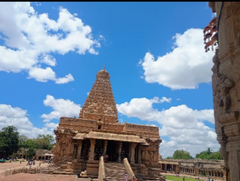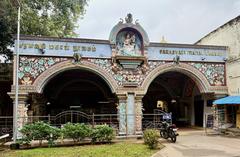Visiting Thanjavur Maratha Palace: Tickets, Hours, and Travel Tips
Date: 16/08/2024
Why Visit Thanjavur Maratha Palace?
The Thanjavur Maratha Palace, known locally as Aranmanai, stands as a monumental testament to the rich and diverse heritage of Thanjavur, India. This architectural wonder, which blends Maratha, Nayak, and European styles, offers visitors a unique glimpse into the historical and cultural legacy of the region. Originally constructed in the early 16th century by the Nayak rulers and later expanded by the Marathas, the palace is a site of historical significance and a vibrant cultural hub. From the intricate carvings of the Durbar Hall to the vast collection of ancient manuscripts in the Saraswati Mahal Library, each corner of the palace tells a story of its own (Thanjavur Tourism; Laure Wanders). The complex, which includes key structures like the Bell Tower, the Raja Serfoji Memorial Hall, and the Royal Family’s Temple, offers a deep dive into the architectural and cultural evolution that took place over several centuries. Whether you are a history enthusiast, an architecture lover, or a curious traveler, this guide will provide comprehensive information on visiting hours, tickets, travel tips, and nearby attractions to ensure a fulfilling visit to the Thanjavur Maratha Palace.
What You Will Find in This Guide
- Introduction
- Historical Background
- Architectural Highlights
- Visitor Information
- Nearby Attractions
- Cultural Significance
- Preservation and Restoration
- FAQ
- Conclusion
- Sources
Introduction
The Thanjavur Maratha Palace, also known locally as Aranmanai, is a historical and cultural landmark that offers a glimpse into the rich heritage of Thanjavur. This architectural marvel showcases a blend of Maratha, Nayak, and European styles and stands as a testament to the enduring legacy of the Nayak and Maratha rulers. This guide provides comprehensive visitor information, including visiting hours, tickets, and travel tips, to ensure you make the most of your visit to this iconic palace.
Historical Background
Origins and Construction
The Thanjavur Maratha Palace dates back to the early 16th century, originally constructed by the Thanjavur Nayak rulers. The construction began in 1534 and was completed in 1535, utilizing the labor of local prisoners of war (Thanjavur Tourism).
Nayak Dynasty
The Nayak dynasty was responsible for the initial construction of the palace, creating a strong foundation that would later be expanded upon by subsequent rulers.
Transition to Maratha Rule
In the late 17th century, the Maratha rulers took control of Thanjavur and expanded the palace, blending their architectural styles with those of the Nayaks, resulting in a unique fusion of designs.
British Annexation
During the British annexation, parts of the palace were adapted for administrative purposes. However, the core structures have retained their historical and architectural integrity.
Architectural Evolution
Over several centuries, the palace underwent numerous modifications and additions, reflecting the changing architectural styles and influences of the time.
Architectural Highlights
Key Structures and Features
- Durbar Hall: Known for its intricate craftsmanship, the Durbar Hall was used for royal gatherings and celebrations. Its walls and ceilings are adorned with exquisite murals and detailed frescoes (facts.net).
- Saraswati Mahal Library: One of the oldest libraries in Asia, housing a vast collection of ancient manuscripts, books, and documents (facts.net).
- Sprawling Courtyards and Gardens: The palace complex covers around 24 acres, featuring multiple sections, including courtyards, gardens, museums, and residential quarters (facts.net).
- Intricate Carvings and Sculptures: Detailed carvings adorn the walls, pillars, and ceilings, depicting various mythological and historical scenes (cultureandheritage.org).
- Majestic Domes and Towers: Designed in the Dravidian style with intricate detailing and ornate decorations (cultureandheritage.org).
Architectural Significance
The palace is a marvel of architectural engineering, showcasing the skill and craftsmanship of the artisans who built it. The design reflects the ingenuity of the architects and craftsmen of the time, who created a structure that continues to inspire awe and admiration centuries later (cultureandheritage.org).
Visitor Information
Tickets and Visiting Hours
- Visiting Hours: 9:00 AM to 6:00 PM daily.
- Ticket Prices:
- Adults: INR 50
- Children (below 12 years): INR 25
- Foreign Nationals: INR 200
How to Get There
The palace is easily accessible by road, rail, and air. Thanjavur is well-connected to major cities in Tamil Nadu and other parts of India.
Travel Tips
- Best Time to Visit: October to March, when the weather is pleasant.
- Guided Tours: Hiring a local guide is recommended for detailed insights.
- Photography: Allowed in most parts, but check for any restrictions.
- Dress Code: Modest clothing is advisable as a sign of respect.
Nearby Attractions
- Brihadeeswarar Temple: A UNESCO World Heritage Site and an architectural marvel.
- Thanjavur Art Gallery: Showcases a stunning collection of Chola bronzes and stone sculptures.
- Sivaganga Park: Ideal for a leisurely stroll and relaxation.
Cultural Significance
The palace served as the official residence of the Maratha kings and played a central role in the cultural and political affairs of the region. It houses an impressive collection of art and artifacts, providing insights into the opulent lifestyle of the Maratha rulers (facts.net).
Preservation and Restoration
Restoration efforts have been undertaken to preserve the palace’s glory, ensuring that future generations can appreciate its historical importance. The palace has been declared a protected monument by the Archaeological Survey of India (facts.net).
FAQ
Q: What are the Thanjavur Maratha Palace visiting hours? A: The palace is open from 9:00 AM to 6:00 PM daily.
Q: How much are the tickets for Thanjavur Maratha Palace? A: Ticket prices are INR 50 for adults, INR 25 for children below 12 years, and INR 200 for foreign nationals.
Q: Are guided tours available? A: Yes, guided tours are available and are highly recommended for a detailed understanding of the palace’s architecture and history.
Q: What is the best time to visit Thanjavur Maratha Palace? A: The best time to visit is between October and March when the weather is pleasant.
Conclusion
The architectural significance of the Thanjavur Maratha Palace lies in its intricate design, majestic structures, and historical importance. From the impressive Durbar Hall to the intricately carved pillars of the Saraswati Mahal Library, every corner of the palace reveals a story waiting to be unraveled. The palace’s architectural brilliance continues to captivate visitors from around the world, making it a must-visit destination for architecture enthusiasts, history buffs, and curious travelers alike. Plan your visit, explore its grandeur, and immerse yourself in the rich history of Thanjavur.
Sources and Further Reading
- Thanjavur Tourism. (n.d.). Retrieved from Thanjavur Tourism
- Laure Wanders. (n.d.). Retrieved from Laure Wanders
- Holidify. (n.d.). Retrieved from Holidify
- Wikipedia. (n.d.). Retrieved from Wikipedia
- Thrilling Travel. (n.d.). Retrieved from Thrilling Travel
- Tamil Nadu Tourism Info. (n.d.). Retrieved from Tamil Nadu Tourism Info
- Solo Passport. (n.d.). Retrieved from Solo Passport
- facts.net. (n.d.). Retrieved from facts.net
- cultureandheritage.org. (2024, March). Retrieved from cultureandheritage.org
- travel.india.com. (n.d.). Retrieved from Travel India


